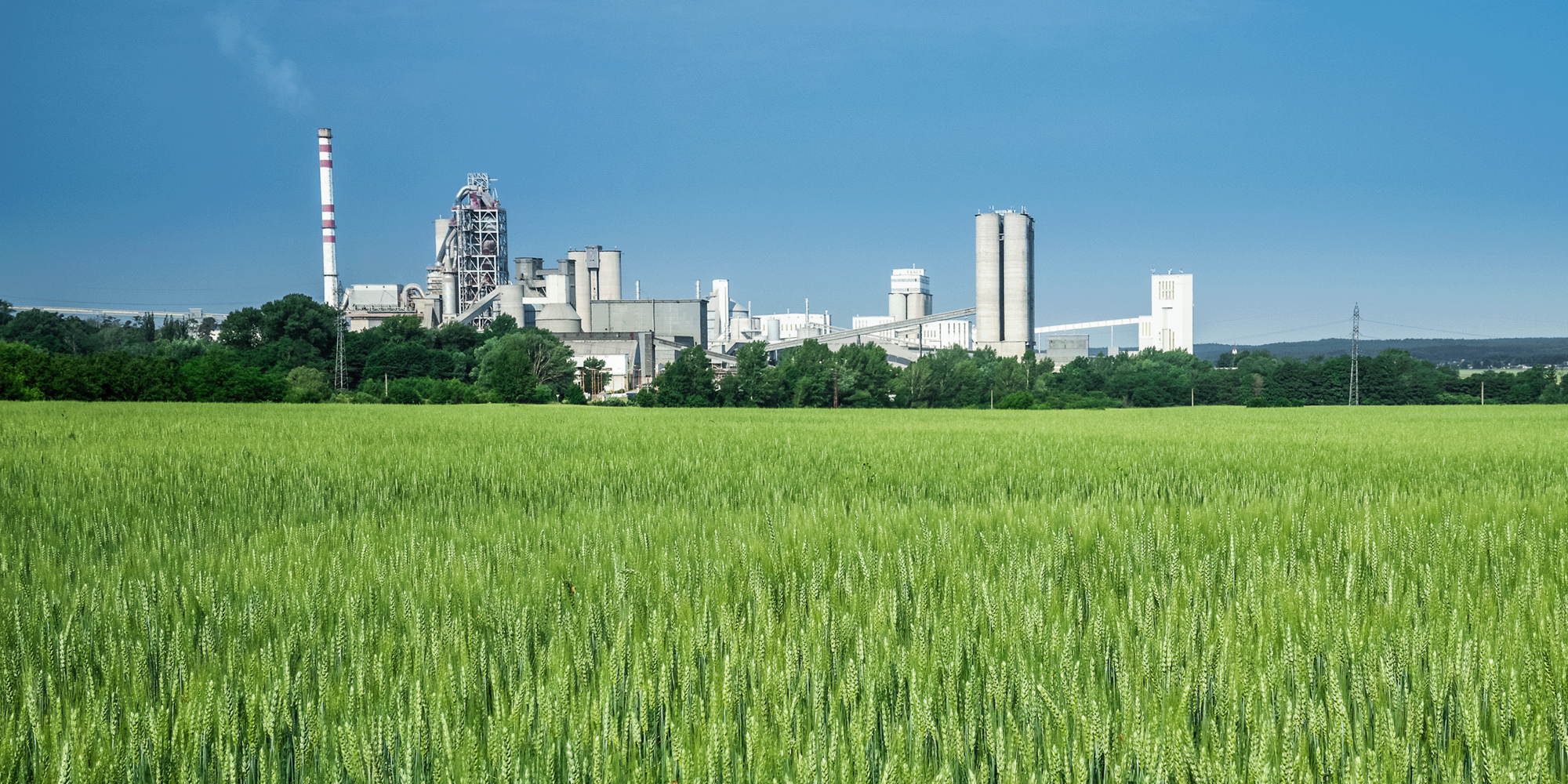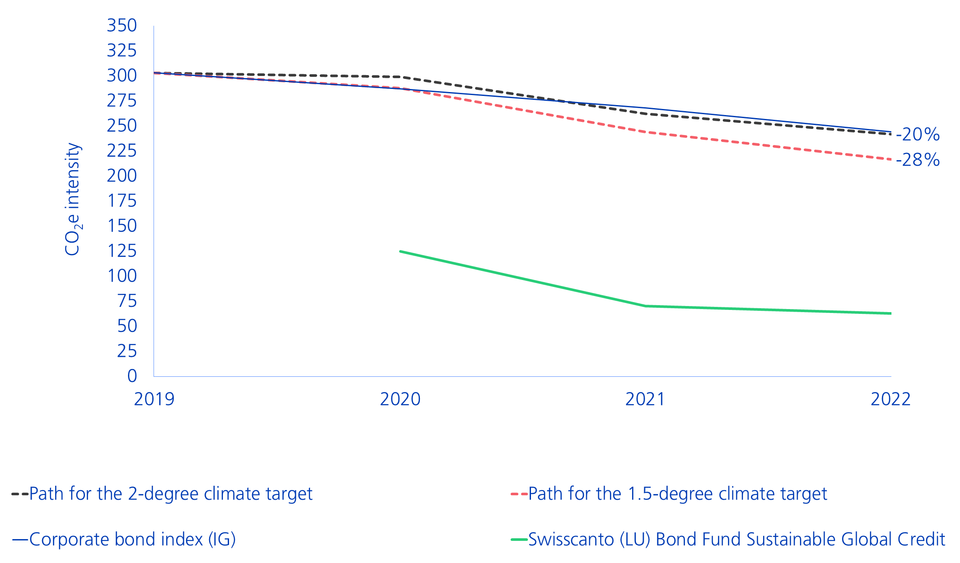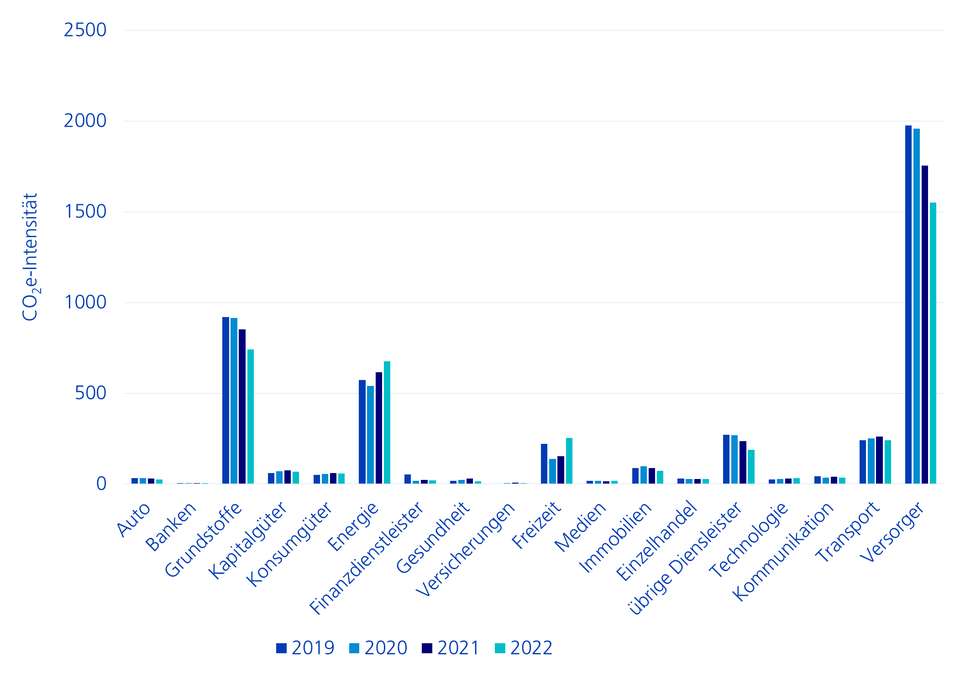CO2 reduction – are companies on track?
For three years now, Zürcher Kantonalbank's Asset Management has also been striving to achieve the Paris climate targets in the actively managed corporate bond funds. We take stock in this article and reach both a positive and a negative finding.
Text: Samuel Manser

Specifically, since 2020 we have also been striving to reduce the CO2e intensity (defined as tonnes of CO2e/USD million in sales) of the investments in corporate bond funds by 4% per year plus economic growth. For the active corporate bond funds in the Sustainable series, we are even aiming for the 1.5-degree climate target, which corresponds to an annual reduction of 7.5% plus economic growth.
For companies, all Scope 1 and Scope 2 greenhouse gases regulated in the Kyoto Protocol are taken into account. Scope 3 greenhouse gas data is not included due to the lack of data availability and quality.
Scope 1, 2 & 3
The categorisation of greenhouse gas (GHG) emissions into scope 1, 2 or 3 is based on the Greenhouse Gas Protocol (GHG Protocol). The aim is to measure and document the greenhouse gas emissions generated over the entire life cycle of a product or service (from the extraction of raw materials to the disposal of a product).
Scope 1 concerns the emission of greenhouse gases by the company itself
Scope 2 concerns greenhouse gas emissions from purchased energy
Scope 3 concerns greenhouse gas emissions in the upstream and downstream supply chains
Three years have now passed. There is one positive and one negative finding in relation to corporate bonds.
The positive finding is that global investment grade (IG) corporate bonds are overall on course for the 2-degree target. The development of the CO2e intensity of the corporate bond market since 2019 roughly corresponds to the target path of -20% cumulatively, which is required to achieve the 2-degree target. However, the more ambitious 1.5-degree climate target will not be achieved, as shown in the chart below.
Development of the CO2e intensity of investment grade corporate bonds

Our Swisscanto Bond Fund Sustainable Global Credit is committed to achieving the more demanding 1.5-degree climate target. Since its launch, the fund has clearly met the requirements.
Few sectors dominate
The CO2e intensity of the corporate bond market is dominated by the utilities, raw materials and energy sectors, which exhibit the highest greenhouse gas emissions. They make up 20% of the market capitalisation, but contribute almost 90% to the CO2e intensity of the universe, as shown in the chart below.
CO2e intensity per sector

Versorger profitieren vom Boom der erneuerbaren Energien
Versorgungsunternehmen haben absolut die höchste CO2e-Intensität. Sie reduzierten diese während den vergangenen drei Jahren um gut 20 % und trugen damit über die Hälfte zur Treibhausgas-Reduktion des Markts bei. Diese wurde möglich, weil die Stromgestehungskosten für erneuerbare Energien dank technologischen Fortschritten und Skaleneffekten deutlich gesunken sind. Für Solar- oder Windenergie liegen sie um 60 % tiefer als noch vor zehn Jahren. Mehr noch: Laut dem Nachrichtenportal Bloomberg produzieren Windparks und Solartracker derzeit zum ersten Mal günstiger Strom als Kohle- oder Erdgaskraftwerke. Als Konsequenz generieren Versorger den Strom zunehmend aus erneuerbaren Quellen und reduzieren so ihre CO2e-Intensität.
Unternehmen des Grundstoff-Sektors emittieren nach den Versorgern am zweitmeisten Treibhausgase. Dazu zählen beispielsweise die Zementhersteller. Gerade in der Zementindustrie werden bedeutende Investitionen zur Reduktion der Treibhausgase getätigt. Das ist mit ein Grund, weshalb auch dieser Sektor auf Kurs ist.
Nachholbedarf auf Einzelschuldner-Ebene
Die erfreuliche Entwicklung des Gesamtmarkts verantworten primär Energieversorger und Hersteller von Grundstoffen. Teilt man den Gesamtmarkt in die einzelnen Sektoren und Einzelschuldner auf, entsteht indes ein anderes Bild. Dieses zeigt nämlich, dass die Reduktion der CO2e-Intensität der Schuldner im Median bloss 13 % beträgt und damit deutlich unterhalb des 2-Grad-Reduktionspfads von 20 % liegt. Nur etwa zwei von fünf Unternehmen sind auf Kurs. Mit wenigen Ausnahmen sind auch die meisten Sektoren nicht auf Zielpfad.
Aktuell kann dies zwar mit den Sektoren Versorger und Grundstoffe kompensiert werden. Das wird aber künftig schwieriger werden. So beziffert die World Meteorological Organization (WMO), dass eine Verdoppelung der Kapazitäten für saubere Energie bis 2030 nötig ist, um das Pariser Klimaziel erreichen zu können. Gemäss WMO entsprechen die aktuellen Zusicherungen der Staaten weniger als der Hälfte davon. Deshalb ist davon auszugehen, dass der Versorgersektor und auch der gesamte IG Unternehmensanleihen-Markt deutlich hinter den Zielpfad zurückfallen werden, wenn die Anstrengungen nicht deutlich verstärkt werden.
Mit aktivem Dialog mit Unternehmen (Investment Stewardship) und der Kapitalallokation stellen wir sicher, dass auch in Zukunft das Klimaziel in den entsprechenden Fonds erreicht werden kann.


